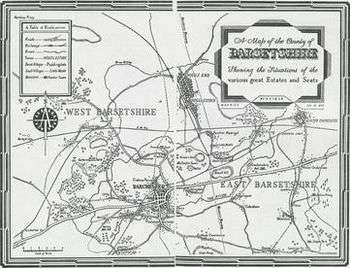Barsetshire
| Barsetshire | |
|---|---|
|
1953 map by Maurice Weightman published as endpapers for Thirkell's Jutland Cottage | |
| Chronicles of Barsetshire location | |
| Created by | Anthony Trollope |
| Genre | Novels |
| Type | Fictional county |
| Notable locations | Barchester, Silverbridge, Hogglestock |
| Notable characters | Mr Septimus Harding, Bishop and Mrs Proudie, Dr Thomas Thorne, Archdeacon Theophilus Grantly |
Barsetshire is a fictional English county created by Anthony Trollope in the series of novels known as the Chronicles of Barsetshire. The county town and cathedral city is Barchester. Other towns in the novels include Silverbridge, Hogglestock and Greshamsbury.
In Doctor Thorne Trollope describes how the county, formerly represented by a single parliamentary constituency, was split into two constituencies, the more rural East Barsetshire, which includes Barchester, and the more commercial West Barsetshire, by the Reform Act 1832. The borough of Silverbridge, according to the Palliser novels, also elects a Member of Parliament.
The novel Barchester Pilgrimage (1935), and some of the episodes in Let Dons Delight (1939), both by Ronald Knox, refer to Barsetshire and its inhabitants.
Barsetshire was also used as the setting for a series of 29 novels by Angela Thirkell, written from 1930 to 1961. Thirkell's stories blend social satire with romance.
Barsetshire is also used in some of the Pullein-Thompson sisters books, usually referring to rival teams or as a nearby county.
Barchester and Barset were used as names for the fictional county in which St Trinians School was supposedly located in the original films.
The county is also mentioned in Michael Innes's Appleby and Honeybath where it is suggested that "the shifting of county boundaries has pretty well done away with Barsetshire". (p 27)
Barchester is used as a railway station and location for some of the 1942 Ealing Studios film The Black Sheep of Whitehall.
Barchester Cathedral was used as the setting for the ghost story The Stalls of Barchester Cathedral by M. R. James in his 1911 collection More Ghost Stories.
